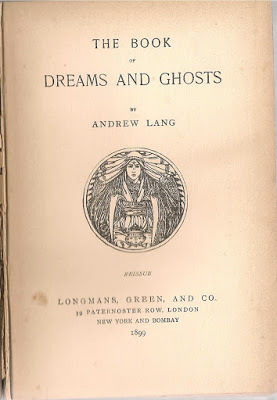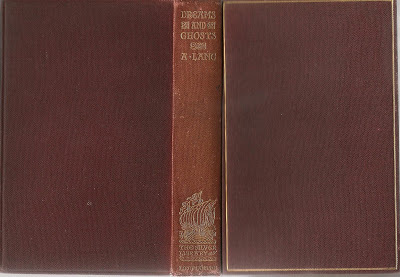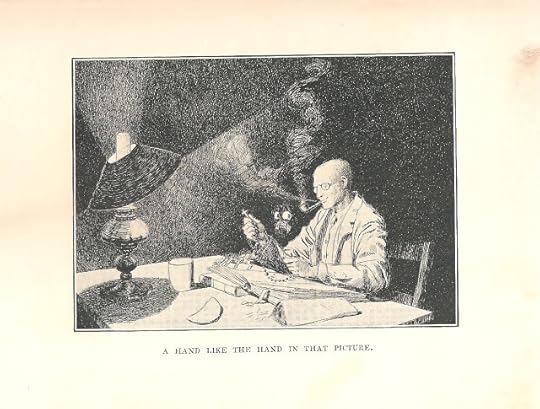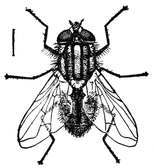Dreams and Ghosts

I do love old books. They don't make them like that any more. I love the smell, the thick silky quality of the paper, the rough-cut, uneven edges, the gilt-embossed covers, the blackness of the print, and the tactile sense of so many other hands which have held it and turned the pages... A few years ago, wandering the labyrinthine passageways of our local second hand bookshop, I came across this 1899 edition of Andrew Lang’s The Book of Dreams and Ghosts. Even if I’d never heard of Andrew Lang I couldn’t have resisted that title. I bought it for a couple of pounds.

What it is, is pretty much what it says on the cover. A collection of supernatural or ghostly anecdotes taken from all kinds of sources: the key element being that none of them were originally offered as fiction. They are all, for what it’s worth, ‘true stories’. Many are contemporary accounts sent to Andrew Lang by various friends. Some are historical, but even the ones from old Icelandic sagas were intended to be read as factual accounts.
Lang was interested in recording and investigating what might loosely be termed supernatural phenomena, and in 1911 he was President of the Society for Psychical Research, but he was neither a believer nor a sceptic; of course his other interests lay in folklore, anthropology and fairy tales.
The author has frequently been asked, both publicly and privately: “Do you believe in ghosts?” One can only answer: “How do you define a ghost?” I do believe, with all students of human nature, in hallucinations of one, or of several, or even of all the senses. But as to whether such hallucinations, among the sane, are ever caused by psychical influences from the minds of others, alive or dead, not communicated through the ordinary channels of sense, my mind is in a balance of doubt. It is a question of evidence.
There is a great difference between a supposedly ‘true’ ghost story and a fictional one. I once lived in a small Yorkshire village full of very old houses (the one I myself lived in dated in part from the late seventeenth century). Our neighbours in the even older whitewashed farmhouse down by the beck had a Red Lady who sometimes looked out of one of the small upstairs windows. And they were used to hearing footsteps cross the floor overhead, when no one should be there. But that was it: there was no story attached. Further down the road there was a ford across the beck, and a medieval ‘clapper bridge’ made of two huge stone slabs known as ‘Monks Bridge’, probably because Fountains Abbey used to own much of the land. The cottage nearby was said to be haunted. Coming on foot up the unlit road one dark chilly night at about two o’clock in the morning, I was disconcerted to see someone lingering near the bridge, wearing a hooded garment which I took to be a cagoule. As I passed, the hooded person – whoever it was – slowly and very silently moved away from me down towards the ford and the rushing water. I didn’t think ‘ghost’, I thought ‘oddball’ and hurried on. Later, I wondered… And my own aunt was well known in the family for seeing the dead, including her husband, who once – pipe in hand – politely drew back to allow her to pass through a door in her Leeds Victorian terrace, some months after he had died.
The point about these stories is that there is no point. They have no real beginning, no middle, no end, no structure. They aren’t stories at all – just anecdotes. You hear them, you are impatient or fascinated according to your nature – and then you shrug, because there is no way to take them any further. People love explanations, of course, so sometimes there is an attempt to provide some kind of Gothic rationale involving hidden treasure, wicked lords, seduced nuns, suicides and murders. These are rarely convincing. ‘Real’ ghost stories (and nearly everybody knows one) are open-ended oddities, and quite frequently the person involved does not realise anything strange is happening until afterwards.
Here’s an example from Lang’s book:
The brother of a friend of my own, a man of letters and wide erudition, was, as a boy, employed in a shop. The overseer was a dark, rather hectic-looking man, who died. Some months afterwards the boy was sent on an errand. He did his business, but, like a boy, returned by a longer and more interesting route. He stopped at a bookseller’s shop to stare at the books and pictures, and while doing so felt a kind of mental vagueness. It was just before his dinner hour and he may have been hungry. On resuming his way, he looked up and found the dead overseer beside him. He had no sense of surprise, and walked for some distance, conversing on ordinary topics with the appearance. He happened to notice such a minute detail as that the spectre’s boots were laced in an unusual way. At a crossing, something in the street attracted his attention; he looked away from his companion, and, on turning to resume their talk, saw no more of him.
Here a number of details (the ‘dark and hectic’ features of the dead man; the curiously-laced boots), are presented as corroborative evidence. If the boy could describe the boots so minutely – well, he must have seen something! This sort of ghost story is very much alive and well in the oral tradition. ‘A funny thing happened…’ ‘A friend of mine told me…’ We enjoy listening; at least I do – but the teller is excused the structure of the literary ghost story. Because what happened is ‘real’, no other framework is necessary. M.R. James is very, very good at convincing his readers that his ghosts are real, and one of the ways he does it is to build in these inconsequential details ("the red cloth just by his left elbow") that underwrite the supernatural invasion. Here his scholarly hero Dennistoun is murmuring peacefully (for the moment) to himself, as he studies Canon Alberic's scrapbook:
“Dear me! I wish that landlady would learn to laugh in a more cheering manner; it makes one feel as if there was someone dead in the house. Half a pipe more, did you say? I think perhaps you are right. I wonder what that crucifix is that the young woman insisted on giving me? Last century, I suppose. Yes, probably. It is rather a nuisance of a thing to have round one’s neck – just too heavy. ...I think I might give it a clean up before I put it away.”
He had taken the crucifix off and laid it on the table, when his attention was caught by an object lying on the red cloth just by his left elbow. Two or three ideas of what it might be flitted though his brain with their own incalculable quickness.
“A penwiper? No, no such thing in the house. A rat? No, too black. A large spider? I trust to goodness not – no. Good God! a hand like the hand in that picture!”
 Few ‘true’ ghost stories are as good as the strange tale of Margaret Richard, reported in a book called ‘The Appearance of Evil: Apparitions of Spirits in Wales’ by Edmund Jones, an eighteenth century Welsh minister who compiled narratives of supernatural encounters in an attempt to prove the existence of both God and the Devil. Margaret’s sweetheart got her pregnant and then jilted her at the altar, sending word he was too sick to come. Furious, Margaret fell on her knees and prayed he should have no rest in this world or the next. He must really have been sick, though, for shortly afterwards he died and his ghost kept appearing to Margaret until finally she took his hand and forgave him. He vanished and never troubled her again, but here’s the creepy bit: ‘His hand did not feel like the hand of a man, but like moist moss.’
Few ‘true’ ghost stories are as good as the strange tale of Margaret Richard, reported in a book called ‘The Appearance of Evil: Apparitions of Spirits in Wales’ by Edmund Jones, an eighteenth century Welsh minister who compiled narratives of supernatural encounters in an attempt to prove the existence of both God and the Devil. Margaret’s sweetheart got her pregnant and then jilted her at the altar, sending word he was too sick to come. Furious, Margaret fell on her knees and prayed he should have no rest in this world or the next. He must really have been sick, though, for shortly afterwards he died and his ghost kept appearing to Margaret until finally she took his hand and forgave him. He vanished and never troubled her again, but here’s the creepy bit: ‘His hand did not feel like the hand of a man, but like moist moss.’ No one could have made that up! is the first reaction to this kind of thing. But of course the ability to do just that is one of the prerequisites for writing a successful fictional ghost story. If Edmund Jones had not been a minister, he had the imaginative and descriptive power to have become an excellent ghost story writer. Here he lies half-awake in a dank Monmouthshire bedroom ‘partly underground and known to be an unfriendly place’, being assailed by Satan:
After I had slept some time and awaked, the enemy violently came upon me. I heard him say in my ear: ‘Here the devil comes in his strength.’ (And that was true.) He made a noise by my face, such as is made when a man opens his mouth wide and draws in his breath, as if he would swallow something. He also made a sound over me like that of dry leather and, by my left ear, a sound something like the squeaking of a pig. The clothes moved under me and my flesh trembled, and the terror was so great that I sweated under the great diabolical influence.
He must at least, if you will excuse me, have been one hell of a preacher.
The least strained of traditional explanations for hauntings is that the troubled spirit cannot rest until some wrong it did or suffered in life has been put right. Here’s another account from Andrew Lang’s book, verbatim from a seventeenth century pamphlet with the pleasing title: Pandaemonium, or the Devil’s Cloister Opened. Notice again the use of incidental details to lend verisimilitude:
About the month of November in the year 1682, in the parish of Spraiton, in the county of Devon, one Francis Fey (servant to Mr Philip Furze) being in a field near the dwelling place of his said master, there appeared to him the resemblanceof an aged gentleman like his master’s father, with a pole or staff in his hand, resembling that he was wont to carry when living to kill the moles withal… The spectrum…bid him not to be afraid of him, but tell his master that several legacies which by his testament he had bequeathed were unpaid, naming ten shillings to one and ten shillings to another…
This restless spirit was considered of dubious origin – suspicions soon gratified by events. The ghost was joined by that of his second wife, after which the neighbourhood was plagued with poltergeist activities which nowadays might point to the aptly named Francis Fey himself as the source of the problems:
Divers times the feet and legs of the young man have been so entangled about his neck that he has been loosed with great difficulty: sometimes they have been so twisted about the frames of chairs and stools that they have hardly been set at liberty.
Hmm. However, Fey’s master and neighbours pitied him as a victim of the simple malevolence of the devil, so no further explanation seemed to be required.
Lang’s book touches upon all kinds of occult anecdotes, from premonitory dreams (“mental telegraphy”) to the full blown and richly detailed ghost story of the ‘Hauntings At Fródá’ from Eyrbyggja Saga. Too long to retell here, the tale follows the disastrous series of events following the death of the strange Hebridean woman Thorgunna at the farm of Fródá on Snaefellness, when her hostess Thurid refuses to honour a deathbed promise to burn Thorgunna’s sumptuous bed-hangings, which Thurid had long coveted. It has to be one of the best and most matter-of-fact accounts ever of ghost-as-reanimated-corpse – a phenomen which Iceland does particularly well – and ends on another splendidly Icelandic note when the hosts of the dead are finally driven away by a legal decision in a court of law. Though obviously ‘written up’ by the author of the saga, this retains much of the loose-ended mystery of the oral tradition. We never find out any more about Thorgunna, or quite why the violation of the taboo laid on her bed-hangings should have had such drastic consequences.
For me, the very best literary ghost stories are those which manage to combine the best of both worlds – enough of a structure to provide a balanced, causal feel to the story, enough open-ended mystery to fascinate. A ghost story which is tied off too tightly is never entirely satisfying. They are very hard things to write, especially if you want to avoid Victorian pastiche. I recommend Alison Lurie's collection of short stories 'Women and Ghosts', Robert Westall's 'The Stones of Muncaster Cathedral' (Westall was very good at ghosts), Candy Gourlay's 'Shine', and Michelle Paver's brilliant and chilling novella 'Dark Matter'. To end with, here’s a ‘true’ ghost story told to me in the good old classic fashion by a friend, some years ago when I lived in France.
My friend was an American woman married to a Frenchman. They lived in a modern house in Fontainebleau, but her husband had elderly aunts who owned a little chateau – no doubt one of those elegant small eighteenth century houses with shuttered windows and walled grounds that are scattered around the French countryside. This one was somewhere north of Paris, and the family would descend upon it for get-togethers at Christmas and Easter.
The bedrooms all had names, a charming custom – the Chambre Rouge, the Chambre Jaune, etc – but, said my friend, there was one bedroom everyone hoped they wouldn’t get, which latecomers would unavoidably be stuck with – the Chambre des Mouches: ‘The Bedroom of the Flies.’
It wasn’t just, my friend said, that there always seemed to be a number of flies in the room – big, sleepy, buzzy flies, crawling on the windows. One of the windows had been walled up, which was a little creepy. And there was a small powder room off the main chamber, which might once have used as a nursery. But, mainly, you never got a good night’s sleep there. You lay awake listening to noises. As if something was shuffling about, or dragging something across the floor. That was all. But she didn’t like it.
And so when an American friend called Meredith came visiting from the States and a visit to the chateau was proposed and she was given the Chambre des Mouches, no one in the family said anything. Because the house was full and no other bedroom was available, and really, the whole thing was probably nonsense… but there was a certain interest around the breakfast table next morning when Meredith came downstairs.
“How did you sleep?” they asked. Meredith hesitated. “Oh, I was comfortable enough – but I didn’t sleep too well because of that darned cuckoo clock. It went off every hour, bing bong, cuckoo, cuckoo, cuckoo, and kept waking me up.”
“But Meredith,” said my friend, as an indrawn breath went around the table, “there isn’t any cuckoo clock.”

Picture credits
Book of Dreams and Ghosts - Katherine LangrishIllustration from Canon Alberic's Scrapbook - James McBrideHousefly - https://upload.wikimedia.org/wikipedi...
Published on April 16, 2016 04:37
No comments have been added yet.



